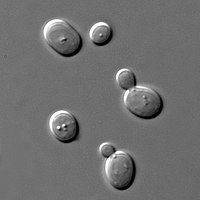
Photo from wikipedia
BackgroundAlkali used for pH control during fermentation and acidification for downstream recovery of succinic acid (SA) are the two largest cost contributors for bio-based SA production. To promote the commercialization… Click to show full abstract
BackgroundAlkali used for pH control during fermentation and acidification for downstream recovery of succinic acid (SA) are the two largest cost contributors for bio-based SA production. To promote the commercialization process of fermentative SA, the development of industrially important microorganisms that can tolerate low pH has emerged as a crucial issue.ResultsIn this study, an in situ fibrous bed bioreactor (isFBB) was employed for the metabolic evolution for selection of Y. lipolytica strain that can produce SA at low pH using glucose-based medium. An evolved strain named Y. lipolytica PSA3.0 that could produce SA with a titer of 19.3 g/L, productivity of 0.52 g/L/h, and yield of 0.29 g/g at pH 3.0 from YPD was achieved. The enzyme activity analysis demonstrated that the pathway from pyruvate to acetate was partially blocked in Y. lipolytica PSA3.0 after the evolution, which is beneficial to cell growth and SA production at low pH. When free-cell batch fermentations were performed using the parent and evolved strains separately, the evolved strain PSA3.0 produced 18.4 g/L SA with a yield of 0.23 g/g at pH 3.0. Although these values were lower than that obtained by the parent strain PSA02004 at its optimal pH 6.0, which were 25.2 g/L and 0.31 g/g, respectively, they were 4.8 and 4.6 times higher than that achieved by PSA02004 at pH 3.0. By fed-batch fermentation, the resultant SA titer of 76.8 g/L was obtained, which is the highest value that ever achieved from glucose-based medium at low pH, to date. When using mixed food waste (MFW) hydrolysate as substrate, 18.9 g/L SA was produced with an SA yield of 0.38 g/g, which demonstrates the feasibility of using low-cost glucose-based hydrolysate for SA production by Y. lipolytica in a low-pH environment.ConclusionsThis study presents an effective and efficient strategy for the evolution of Y. lipolytica for SA production under low-pH condition for the first time. The isFBB was demonstrated to improve the metabolic evolution efficiency of Y. lipolytica to the acidic condition. Moreover, the acetate accumulation was found to be the major reason for the inhibition of SA production at low pH by Y. lipolytica, which suggested the direction for further metabolic modification of the strain for improved SA production. Furthermore, the evolved strain Y. lipolytica PSA3.0 was demonstrated to utilize glucose-rich hydrolysate from MFW for fermentative SA production at low pH. Similarly, Y. lipolytica PSA3.0 is expected to utilize the glucose-rich hydrolysate generated from other carbohydrate-rich waste streams for SA production. This study paves the way for the commercialization of bio-based SA and contributes to the sustainable development of a green economy.
Journal Title: Biotechnology for Biofuels
Year Published: 2018
Link to full text (if available)
Share on Social Media: Sign Up to like & get
recommendations!